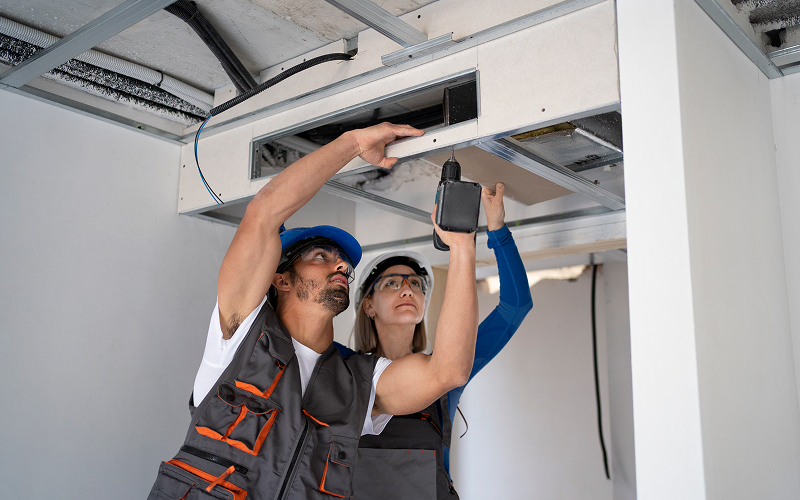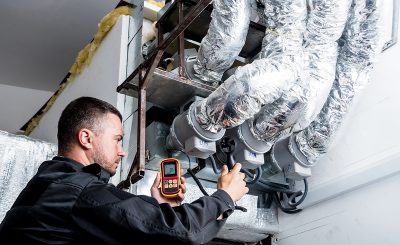Limited ceiling clearance can present serious logistical challenges for a professional air duct cleaning company tasked with servicing ventilation systems. These constraints often occur in older commercial buildings, retrofitted properties, and facilities with intricate architectural layouts. Despite the physical limitations, effective commercial air duct cleaning is still possible through strategic planning, the right equipment, and adapted cleaning methods.
Identifying and Assessing Clearance Constraints
The first step for an air duct cleaning company is to conduct a detailed site assessment. This step involves measuring clearance space above suspended ceilings or in mechanical rooms and identifying obstructions such as beams, piping, lighting fixtures, or electrical conduits. During low-clearance situations, technicians may also review original building plans or recent renovation schematics to understand duct positioning. This pre-cleaning inspection ensures realistic access planning and minimises potential damage to the property.
Choosing Specialised Equipment
Standard duct cleaning machinery may be impractical when ceiling height is limited. Commercial air duct cleaning in these conditions often requires compact, portable, or flexible equipment. Low-profile rotary brushes, slimline air whips, and miniaturised negative air machines are preferred. Flexible vacuum hoses with sectional fittings also allow technicians to manoeuvre through tighter bends and reduced space. Battery-powered tools may also be used to eliminate the need for cumbersome power cables in restricted areas.
Adapting Cleaning Methods
Traditional push-and-pull cleaning methods can be challenging in confined spaces. Instead, a professional air duct cleaning company may employ point-of-contact vacuuming, where debris is immediately extracted at the point of dislodgement. Compressed air agitation tools can be adapted with shorter nozzles to avoid contact with obstructions. Technicians may use sectional cleaning in extreme cases, working through multiple smaller access points rather than relying on a single entry.
ALSO READ: Air Duct Decontamination on Ships: A Critical Step for Crew Safety and System Efficiency
Creating and Using Additional Access Points
The creation of new service openings may be necessary in situations where existing access is insufficient. These are strategically cut into the ductwork to allow insertion of cleaning tools and inspection cameras. The commercial air duct cleaning team ensures that any openings are sealed after cleaning, maintaining the system’s airtightness and compliance with relevant industry standards. Additionally, for heritage or high-specification interiors, access points are planned in discreet locations to preserve the building’s appearance.
Safety and Compliance Considerations
Working in low-clearance spaces increases the risk of injury and demands strict adherence to health and safety protocols. A professional air duct cleaning company ensures that technicians have appropriate personal protective equipment (PPE) and follow confined-space entry procedures when necessary. The cleaning process must also comply with recognised industry guidelines, such as those provided by the National Air Duct Cleaners Association (NADCA) or equivalent British standards, ensuring that both safety and cleaning quality are upheld.
Minimising Disruption to Building Operations
Many low-clearance areas are located above active workspaces, retail areas, or hospitality venues. This instance requires the cleaning process to be scheduled during off-hours or low-traffic periods. Noise control measures, dust containment, and quick reassembly of ceiling panels are essential to avoid extended disruption. An experienced professional air duct cleaning company also coordinates with building management to maintain proper ventilation during cleaning, particularly in settings like hospitals or data centres where airflow is critical.
Conclusion
Managing access in buildings with limited ceiling clearance demands a combination of technical expertise, specialist tools, and strategic planning. A commercial air duct cleaning project in these conditions cannot rely on standard approaches; it requires tailored solutions that prioritise safety, efficiency, and minimal disruption. A professional air duct cleaning company ensures that even the most space-restricted environments receive thorough and compliant ventilation maintenance by using compact equipment, adapting cleaning methods, and creating carefully planned access points.
Visit BELFOR and ensure your building’s air quality and ventilation systems remain at peak performance.






